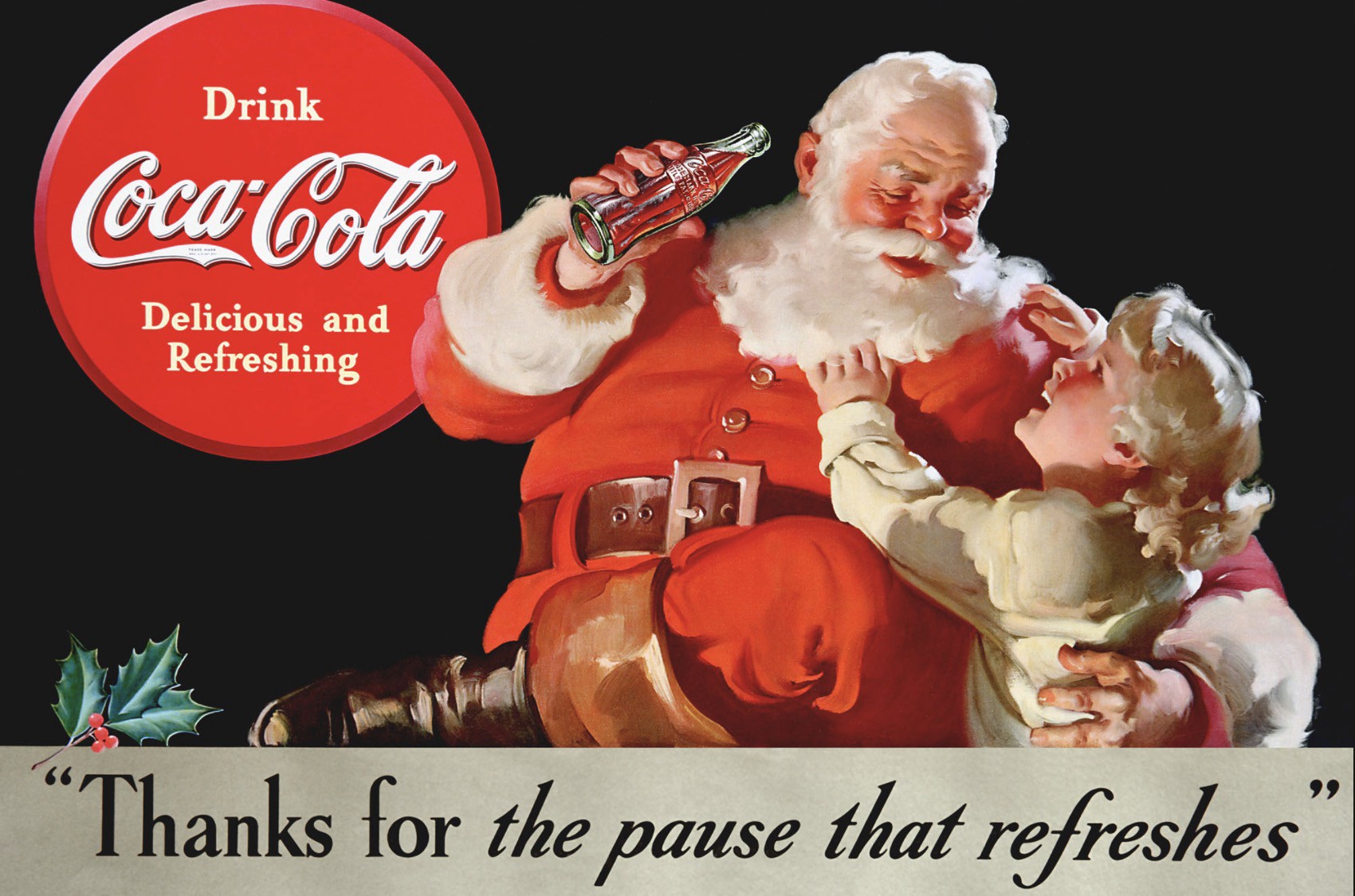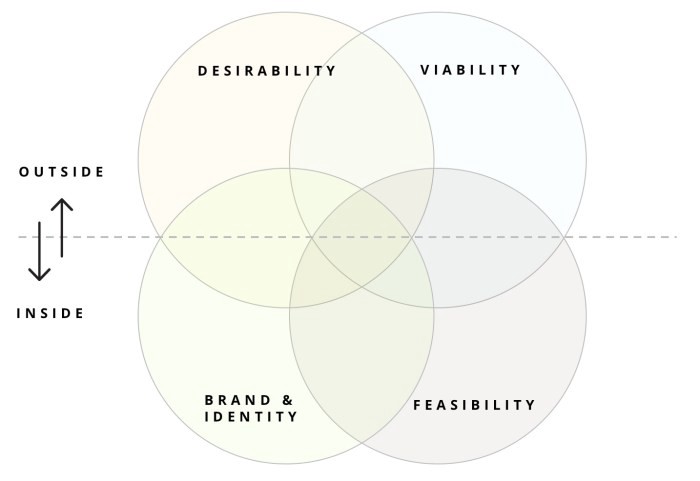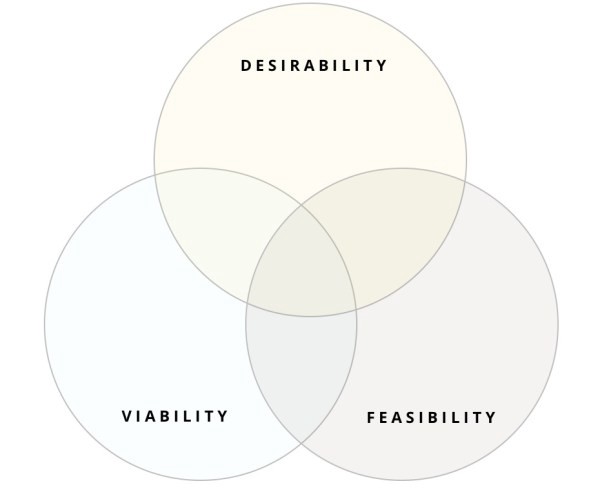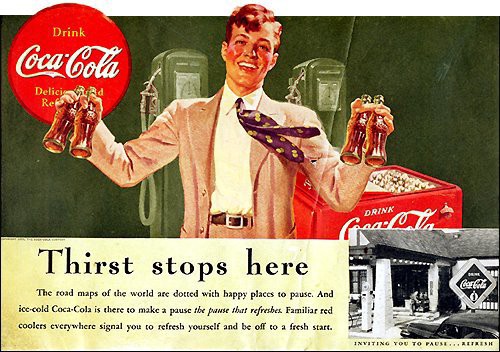Just as ‘we are our brain’, companies ‘are their brand’. It defines why they exist, why they do what they do and what distinguishes them from competition. The often quoted Simon Sinek framework of the ‘why, how and what‘ is a perfect way to answer the question: ‘why are we doing what we’re doing?’, and through it find answers to the most fundamental questions an organization might face.

The three-way design thinking model
A well-known design thinking model
One of the most often used ‘frameworks’ for determining and defining a new value proposition, is a model for positioning experiences is a circular Venn-diagram with desirability, feasibility and viability as main pillars.
This diagram focuses (respectively) on:
- Desirability: what do customers want?
- Feasibility: how can the experience be realized (technical and process-wise) and
- Viability: how are we going to make money (or cut costs)
This is a very useful model and I end up using it a lot myself. It serves its purpose and provides three excellent ‘lenses’ to see if your innovation will become successful. Worldwide, universities (e.g. Parsons) and organizations have adopted this model it and Tim brown (co-founder IDEO), even uses these three lenses to define the very nature of design thinking as a whole:
“Design thinking is a human-centered approach to innovation that draws from the designer’s toolkit to integrate the needs of people, the possibilities of technology, and the requirements for business success.”
— Tim Brown
Great stuff!
Yes, Great stuff. However it kind of bugs me that it fails to encapsulate one very important element: the brand.
Nowadays, the trend of design thinking, service design and related fields all dictate that everything starts and ends with the user in mind. The term user-centered experiences in itself holds the notion that every decision and design choice made along the creative process, should benefit the user, in one way or the other. Empathy, ‘walking in their shoes’, understanding problems, and discovering ‘pain points’ are often heard terms in the crowded forest of UX design and research. I’m not saying these things are not important. On the contrary, without really understanding your customer or user, you might end up with a solution that counters a problem that doesn’t exist. We’re here to improve people lives, and understanding users is an important part of that. Yet, it sometimes bugs me that we seem to lose track of the brand as another very important factor that is often left out of the equation.
Brand Driven innovation
In the Mad Men days, brand was everything. Advertisement cowboys locked themselves up in corner offices on the 30th floor, brainstorming about slogans, taglines, campaigns and other marketing-driven messages. Those ads often were ‘pushed’ onto customers, bombarding people in the streets in all ways possible (“Drink Coca-Cola”, Lucky Strike: “It’s toasted”, etc.). Hardly was there any room for investigating and researching how products would fit in the context of people lives, let alone organize things like co-creation sessions or participatory design (giving people a platform to design themselves, something we see increasinglyhappening. There is even a Participatory Design Conference this year!).
Now, in 2018, with the Mad Men days far behind us, the power balance seems to have shifted the other way: ‘if you’re not putting your customer first in absolutely everything you do, you’re not doing it right’. All around the world, Design departments are filling up, UX research is the hottest buzz word in new product and service development. Bootcamps, hackathons and prototyping sessions are the de facto way of doing innovation, eulogizing the ‘voice of the customer‘ to new heights, making the customer journey to the holy grail in any corporate office.
“UX Research” Google Trends curve (over 14 years)
I starting missing the old days.
The days of true identity, being blunt, being frank, being creative and daring to take a position that is different than the status quo. Virgin, Apple, Diesel, Axe and Southwest still do a great job in putting their name out there and honoring their DNA and heritage, yet so many brands around us fail to make a long-lasting impression.
Erik Roscam Abbing coined the term ‘Brand driven innovation’ (Amazon book link), “a practical, four-step method that will help readers apply brand-driven innovation in their own academic or business context”. As such, the brand is used for inspiration, creation of value and drives a durable relationship between brand and consumer. Roscam Abbing pleads for starting with human centered branding, before continuing to defining innovation and design strategy.
This makes perfect sense: the ‘brand promise‘ is often a good starting point for defining your strategic goals and ambitions, which can be ‘humanized’ by making defining design/guiding principles, based on the brand promise.

For example, Nike’s brand promise is:
“To bring inspiration and innovation to every athlete in the world.”
This could be translated to (personalized) exemplary design principles along the lines of:
- Provide you with state of the art ways to track their progress (innovation)
- Feel part of a wider community that provide inspiration and stimulation to run more (inspiration)
- Be available 24/7, wherever, whenever (from the US to Australia) (every athlete)
See how the brand promise can be ‘humanized’, by basically translating the macro-level brand promise to a micro-level (design) principle? See how powerful that is? How brand has an essential value in product and service development, stemming from an innate belief how the world should be served and improved, by stating what you believe in?
A need for change: Let’s put the brand back in the model
So, with that in mind, I think our three-lenses model needs revision. Desirability, Feasibility and Viability are all equally important, but it lacks the brand and brand identity aspect: the current model fails to answer questions like:
- How will this innovation/service fit my brand?
- How will is strengthen my DNA and my beliefs?
- How does it relate to our brand promise?
Therefore, I plead for adding a circle to the model:
New Design Thinking model with ‘Brand & Identity’ added
In this new model, we keep the three circles but add ‘Brand & Identity’ in the bottom left. Also, you see I’ve slightly shuffled the model so that we can too make a distinction between outside and inside the organization.
Let’s take a closer look:
1. OUTSIDE: Desirability and Viability
Outside-in (see this article for more on outside-in innovation), we have Desirability and Viability:
“what future (customer) experience are we offering and how are we making money off it (very simply put)?”
These are outside factors because they tap into the target group’s needs and characteristics, and can thus vary for different personas and/or segments.
2. INSIDE: Brand & Identity and Feasibility
Inside-out, we find Brand & Identity and Feasibility. Our new friend Brand & Identity answers the question:
“How does this proposition or experience fit our brand and our identity? How is it strengthening our DNA?”
If you cannot answer that question, you might have created the next Unicorn, but apparently you fail to verbalize nor are able to connect how this ‘Unicorn experience’ is going to complement your organization (and brand promise). If you can answer this question, you have not only found a way to create a great new value proposition, but also know how it’s going to strengthen your brand (read this article for more on ‘staying true to your brand’).
Furthermore, feasibility refers to the notion of ‘how are we going to make this possible?’, as mentioned before. This is an internal question/capability because it requires an assessment of resources, technology and the (optimization of) processes.
How can I use this model?
Just as with the old, three-way model, you apply the lenses to your project in various ways:
- As simple ‘check points’, making sure you’re still on track in all 4 areas (e.g. every 2 weeks)
- As parallel work streams, allowing each sub-team to focus on one of the lenses
- As a way to categorize and divide workshops and activities (e.g. UX workshop, Brand workshop, Tech workshop, etc.)
The advantage of having Identity as new framework element is that you can put more emphasis on the brand part by simply applying this model, thus protecting your brand at all times.
Giving the Brand a spot on the stage again
So there we have it: brand has claimed a spot in the innovation triangle. Customer centricity is important, yes. UX research and concept brainstorms are important, no doubt. Journey mapping and gathering pain points will give you interesting, actionable insights, for sure! And now, we also have the brand as stand-alone pillar in innovation: how is your future experience going to impact and strengthen your brand?
— — — — — — — — — —
Originally published on Frankly (www.frankvandeven.com).



